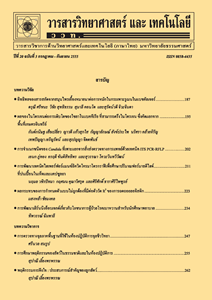การพัฒนาเครื่องหมายดีเอ็นเอ ILP เพื่อศึกษาความหลากหลายทางพันธุกรรมและโครงสร้างประชากรในสบู่ดำ (Jatropha curcas L.)
Main Article Content
Abstract
บทคัดย่อ
ข้อมูล expressed sequence tags (ESTs) สามารถพัฒนาเป็นเครื่องหมายโมเลกุลได้หลายชนิด ในการศึกษานี้เป็นการพัฒนาเครื่องหมายดีเอ็นเอ intron length polymorphism (ILP) จากการทำนายตำแหน่งอินทรอนทั้งหมด 153 อินทรอน จากข้อมูลลำดับเบส EST ของมันสำปะหลัง 30,401 ESTs รวม 386,403 bp โดยเทียบกับข้อมูลลำดับเบสจีโนมจากมันสำปะหลัง และออกแบบไพรเมอร์ได้ทั้งหมด 112 ไพรเมอร์ จากบริเวณของเอ็กซอนที่มีลักษณะอนุรักษ์ซึ่งคร่อมบริเวณของอินทรอนอยู่ โดย 71 ไพรเมอร์ สามารถเพิ่มปริมาณดีเอ็นเอที่มีความจำเพาะตำแหน่งเดียว และได้นำมาใช้เป็นเครื่องหมาย ILP ในการวิเคราะห์ความหลากหลายทางพันธุกรรมและโครงสร้างของกลุ่มประชากรสบู่ดำ (Jatropha curcas) 59 ตัวอย่าง เครื่องหมาย ILP นี้ สามารถตรวจพบแอลลีลทั้งหมด 152 แอลลีล มีค่า PIC (polymorphism information content) เฉลี่ย 0.35 จากวิเคราะห์การจัดกลุ่มตัวอย่างสบู่ดำ สามารถจัดกลุ่มได้ 6 กลุ่มหลัก สอดคล้องกับแหล่งที่มาของตัวอย่าง ค่า coefficient of gene differentiation และ gene flow index แสดงให้เห็นว่าระดับของความแตกต่างทางพันธุกรรมระหว่างกลุ่มประชากรทั้ง 6 กลุ่ม ค่อนข้างต่ำ ผลของ analysis of molecular variance พบว่าความหลากหลายทางพันธุกรรมส่วนใหญ่ (97 %) อยู่ภายในกลุ่มประชากร ซึ่งชี้ให้เห็นถึงการเหลื่อมซ้อนกันของความหลากหลายทางพันธุกรรมของกลุ่มประชากรย่อย เครื่องหมาย ILP ที่พัฒนาจากการทดลองนี้แสดงให้เห็นว่าสามารถใช้เป็นเครื่องหมายในการศึกษาความหลากหลายทางพันธุกรรมภายในสปีชีส์ J. curcas ได้
คำสำคัญ : สบู่ดำ; ความหลากหลายทางพันธุกรรม; ไอแอลพี
Abstract
A large number of expressed sequence tags (ESTs) are available and has facilitated the development of molecular markers in many plant species. In the present study, intron length polymorphism (ILP) markers were developed in silico from EST sequences and genomic sequence of cassava. Of 153 predicted introns, 112 primer pairs were designed to conserved exonic regions flanking introns, using 30,401 cassava unique transcripts alignments to 386,403 bp cassava genomic sequences. Of total primers, 71 primer pairs gave single-copy loci for ILP markers and were selected to assess genetic diversity and population structure of 59 Jatropha curcas accessions. A total of 152 alleles were detected by ILP markers. Average PIC (polymorphism information content) was 0.35. The cluster analysis revealed six groups based on geographic sources or origins of collection. The coefficient of gene differentiation and gene flow index indicated relatively low level of genetic differentiation among the six groups. Analysis of molecular variance showed that the majority (97 %) of genetic diversity was within populations indicating a high level of overlaping and little population subdivision with respect to geographic area. ILPs developed in the present study have been proved to be alternative molecular markers used for studying genetic diversity within species J. curcas.
Keywords: Jatropha; genetic diversity; intron length polymorphism (ILP)


